Physical Address
304 North Cardinal St.
Dorchester Center, MA 02124
Anatomically the spine is organised segmentally, consisting of 7 cervical, 12 thoracic, 5 lumbar, 5 (fused) sacral and 3 to 5 coccygeal vertebrae. Each level, except C1, consists of the following elements: a vertebral body (corpus vertebrae) anteriorly and a vertebral or neural arch (arcus posterior) posteriorly. Together these two structures enclose the spinal canal.
Functionally the spine can be divided into three so-called columns. The anterior column includes the anterior longitudinal ligament (ALL), the anterior annulus fibrosus, and the anterior two-thirds of the vertebral body. The middle column comprises the posterior third of the vertebral body, the posterior annulus fibrosus and the posterior longitudinal ligament (PLL). The posterior column includes the posterior elements with the pedicles, facet joints, laminae, and spinous processes as well as the posterior ligaments.
The vertebral bodies have a thin rim of cortical bone and a central framework of mostly vertically oriented trabeculae. This osseous portion contains stores of phosphate and calcium and has a structural support function. Sclerotic bands can be seen in the vertebral body at the site of fusion between two vertebral components. This is typically seen at the neurocentral junction and in the dens axis. In the dens axis there may be remnants of the subdental synchondrosis. These bony structures are optimally evaluated with computed tomography (CT) imaging and to a lesser extent with magnetic resonance imaging (MRI). On CT imaging vascular channels are often visible and in a post-traumatic setting can be mistaken for small fractures.
The centre of the vertebral body is composed of red bone marrow, which is haematopoietically active. Red and yellow bone marrow are not entirely homogeneous and each contains elements of the other. The vertebral marrow is dynamic, changing with age, immune state, oxygenation, coagulation, and structural needs. The normal adult distribution of bone marrow is reached by the age of 25. With ageing, the bone marrow assumes a more variable appearance, with a reduction in the red cell mass and trabecular bone and increase of the fatty content. These changes appear relatively late in comparison to the changes in the bone marrow in the peripheral skeleton. The distribution of the red bone marrow in a vertebral body is predominantly seen at the metaphyseal equivalents near the endplates and the anterior part of the vertebra. Evaluation of the bone marrow is best done with MRI. In the normal spinal marrow, the distribution patterns of fatty and red marrow were categorised into four patterns by Ricci and colleagues ( Fig. 47.1 ). Pattern 1 describes a uniform low signal on T 1 weighted images with high linear signal around the basivertebral vein; this type is most commonly seen in younger patients aged 30 or less. Type 2 is a band-like high T 1 signal limited to the periphery of the vertebral body. Type 3 is characterised by multiple small indistinct (difficult to visualise) high signal intensity foci on T 1 weighted images throughout the vertebral body. These two patterns (type 2 and 3) are seen with increasing age and typically in persons of 40 years and older. Type 4 is a more severe form of type 3 with multiple larger high signal intensity foci (5 to 15 mm) on T 1 images throughout the vertebral body.
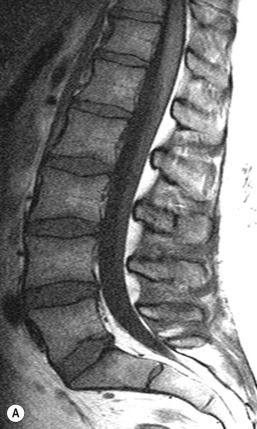
The neural arch, also known as posterior arch, forms the bony lateral and posterior border of the spinal canal ( Figs 47.2–47.4 ). It can be divided into different segments. Between the transverse and spinous process, the neural arch is called the lamina. The pedicle is the part situated between the transverse process and the vertebral body. The pedicle of each vertebra is notched at its inferior and superior edge. Together these notches form an opening called the intervertebral foramen. Through this foramen the spinal nerves exit the spinal canal.
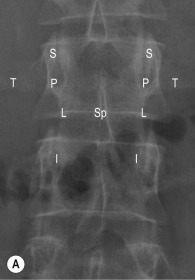
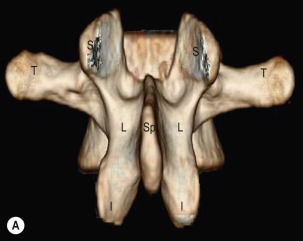
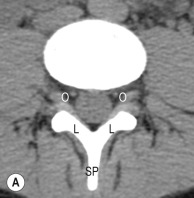
The spinous process is attached to the most posterior part of the neural arch. The transverse processes arise from the lateral edge of each neural arch (see Figs 47.2–47.4 ). The spinous as well as the transverse processes serve as important sites of attachment for the deep back muscles. As described above, they also divide the neural arch into different anatomical parts.
The facet joints or the zygapophyseal joints are diarthrodial synovial joints between the inferior and superior articular processes of adjacent neural arches. These articular processes arise from the articular pillars, including the bone at the junction between pedicles and the laminae. The superior articular process is located relatively anterior to the inferior articular process and faces posteriorly (see Figs 47.2–47.4 ). In the lumbar spine the joint surface is located obliquely at an angle of about 45 degrees between the sagittal and coronal plane. In the thoracic spine the facet joints are almost oriented in the coronal plan.
The inferior facets have a convex shape while the superior articular surface has a concave aspect. In a non-degenerative spine the joint surface is covered with hyaline cartilage, being the thickest in the centre of the joint. In the normal anatomy, as in most joints, the surface of the joints should be smooth and regular with an equal spacing between the two joint surfaces. The distance between the articular processes at the facet joint should be between 2 and 4 mm on plain radiography.
On the posterolateral side, the facet joint is covered with a strong fibrous capsule which is composed of several layers of fibrous tissue and a synovial membrane. On the anterior side of the joint, there is no fibrous capsule. Here, the only border between the spinal canal and the facet joint is formed by the ligamentum flavum and the synovial membrane. The capsule is composed of a superior and inferior recess containing fat pads. These fat pads act as movement-compensating mechanisms and as a lubrication mechanism for the facet joint, as they are partially covered with synovial tissue.
The uncovertebral joints, also known as Luschka joints, are present from C3 to C7. Rarely they are absent at C7 and sometimes they can be seen at T 1 . The lateral aspect of these vertebral bodies have superior projections known as uncinate processes, and with approximation with the vertebra above, they form the uncovertebral joint. The uncinate processes are rudimentary at birth and develop and evolve with age. Their length ranges from 2 to 6 mm. The uncovertebral articulation forms the medial wall of the intervertebral foramen in the cervical region below C2 and, rarely, may be seen on the first thoracic vertebra.
The function of the uncovertebral joint is to maintain stability and mobility in the cervical spine by limiting the side-to-side movement. The overlapping effect allows axial rotation and lateral bending of the cervical vertebrae. The uncinate process also protects against lateral disc herniations into the neural foramen.
The intervertebral disc consists of the inner nucleus pulposus surrounded by an outer layer, the annulus fibrosus. Embryologically the nucleus pulposus is formed from cells originating from the notochord; in humans these notochordial cells are lost and replaced by chondrocyte-like cells. The nucleus pulposus is macroscopically composed of soft, elastic tissue with a yellow colour. The nucleus pulposus is primarily composed of water, proteoglycans, and loose collagen fibres. With normal ageing the water content decreases.
The outer annulus fibrosus is composed of multiple concentric layers of fibrocartilage tissue. The outer layers, also called Sharpey fibres, continue in the longitudinal ligament and the vertebral bodies. The fibres of each layer are directed obliquely (at a 30-degree angle), forming a meshwork. In this way a very strong flexible structure is formed.
A longitudinal ligament is present at the anterior and posterior part of the vertebral bodies running along the entire spine, providing stability ( Fig. 47.5 ). The ALL is a thick ligament which is slightly thinner at the level of the vertebral bodies and wider at the intervertebral disc.
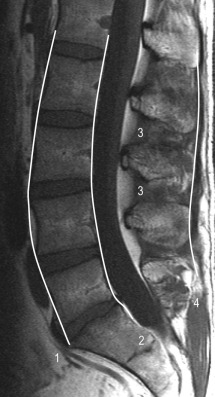
The PLL is situated in the vertebral canal and runs from the dens axis (tectorial membrane) to the sacrum. It is thicker in the thoracic spine and wider in the cervical region compared with the lumbar level. At the level of the vertebral bodies the PLL is separated from the concave posterior wall of the vertebral bodies by the anterior epidural space. This space contains epidural fat, basivertebral veins, and the anterior internal vertebral veins.
The ligamentum flavum or yellow ligament is a paired structure connecting the spinal laminae forming the posterior wall of the spinal canal ( Fig. 47.6 ). At the lateral side these structures fuse with the capsule of the facet joints, forming a boundary of the intervertebral neuroforamina. The boundary between the two ligamenta flava in the centre is indistinguishable on imaging. The ligamenta flava provide a static elastic force to stimulate the return to a neutral position after flexion or extension. They also limit the flexion motion of the spine and help maintain a smooth posterior lining of the central spinal canal.
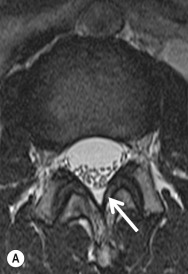
The posterior elements are heavily reinforced with different ligaments connecting two adjacent vertebrae. The supraspinous ligament connects the tips from the spinous processes, while the interspinous ligaments connect the base of the adjacent spinous processes (see Fig. 47.5 ). The transverse processes are connected by the intertransverse ligaments. As discussed earlier the laminae of the adjacent vertebra are bound together by the ligamentum flavum.
Become a Clinical Tree membership for Full access and enjoy Unlimited articles
If you are a member. Log in here